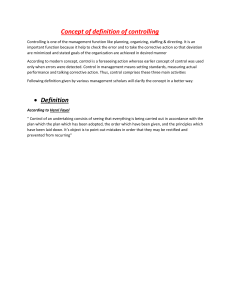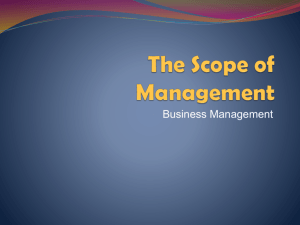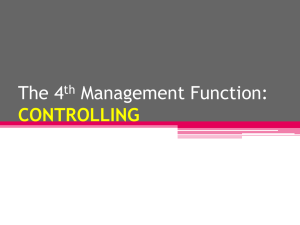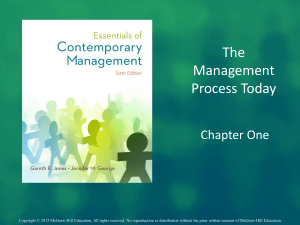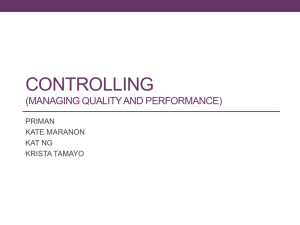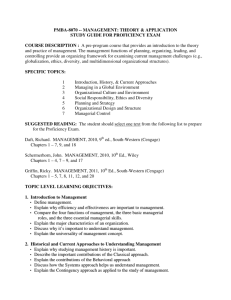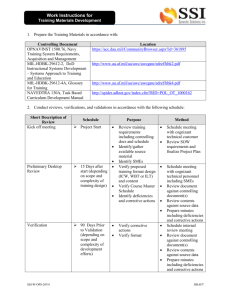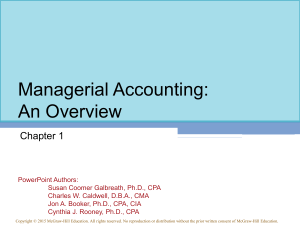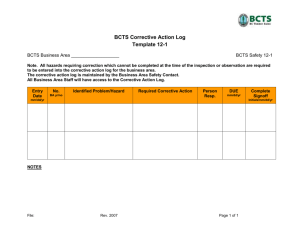The Control Process
advertisement
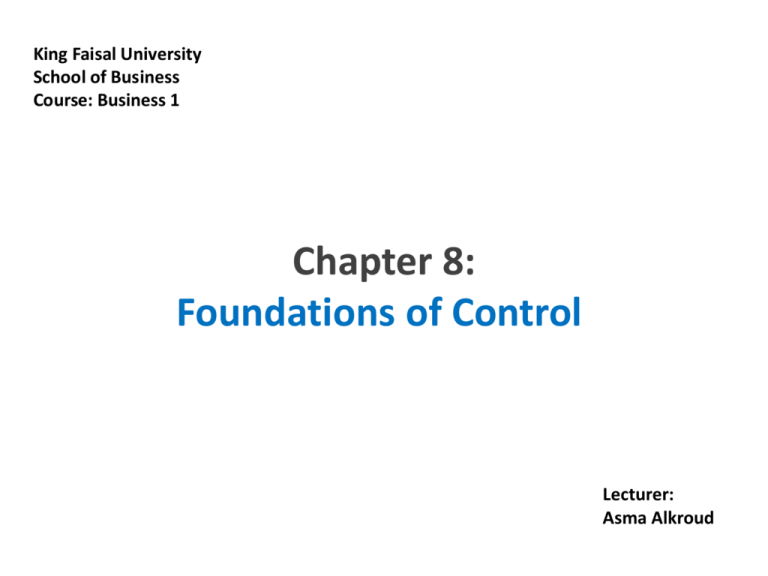
King Faisal University School of Business Course: Business 1 Chapter 8: Foundations of Control Lecturer: Asma Alkroud 10-1 What Is Controlling ? • Controlling: The process of monitoring, comparing, and correcting work performance. • The Purpose of Control: To ensure that activities are completed in ways that lead to the accomplishment of organizational goals. 10-2 Why Is Controlling Important? • As the final link in management functions: – Planning: controls let managers know whether their goals and plans are on target and what future actions to take. – Empowering employees: control systems provide managers with information and feedback on employee performance. – Protecting the workplace: controls enhance physical security and help minimize workplace disruptions. 10-3 Planning-Controlling Link 10-4 The Control Process A three-step process of: Taking managerial action to correct deviations or inadequate standards 10-5 The Control Process (cont.) • Step 1: Measuring Actual Performance – How We Measure: Personal observations, statistical reports, oral reports, and written reports. – What We Measure: What is measured is probably more critical to the control process than how it’s measured. 10-6 Sources of Information for Measuring Performance Benefits Personal Intensive coverage of work observations activities Statistical reports Oral reports Written reports Drawbacks • Subject to personal biases • Time consuming Easy to visualize Provide limited information • Fast way to get information • Allow for verbal & nonverbal feedback. Information can’t be documented • Formal • Easy to file & retrieve Take more time to prepare 10-7 The Control Process (cont.) • Step 2: Comparing Actual Performance Against the Standard – Determining the degree of variation between actual performance and the standard. – Range of variation: The acceptable parameters of variance between actual performance and the standard. 10-8 Acceptable Range of Variation 10-9 The Control Process (cont.) • Step 3: Taking Managerial Action – Immediate corrective action: Corrective action that corrects problems immediately in order to get performance back on track. – Basic corrective action: Corrective action that looks at how and why performance deviated before correcting the source of deviation. 10-10 The Control Process (cont.) • Step 3 (cont.) – Revise the Standard: If performance consistently exceeds the goal, then a manager should look at whether the goal is too easy and needs to be raised. – Managers must be cautious about revising a standard downward. 10-11 Managerial Decisions in the Control Process Depending on the results, a manager decision is to: 1 or or 2 3 10-12 What Is Organizational Performance? • Performance: The end result of an activity. • Organizational performance: The accumulated results of all the organization’s work activities. 10-13 Measures of Organizational Performance • Productivity: The amount of goods or services produced divided by the inputs needed to generate that output. • Organizational effectiveness: A measure of how appropriate organizational goals are and how well those goals are being met. 10-14 Controlling for Employee Performance • Disciplinary actions: Actions taken by a manager to enforce the organization’s work standards and regulations. • Delivering Effective Performance Feedback: Managers need to provide their employees with feedback so that the employees know where they stand in terms of their work. 10-15 Tools for Measuring Organizational Performance 1- Feed forward control: Control that takes place before a work activity is done. 2- Concurrent control: Control that takes place while a work activity is in progress. 3- Feedback control: Control that takes place after a work activity is done. 10-16 Types of Control 10-17 Information Controls • Management information system (MIS): A system used to provide management with needed information on a regular basis. • Data: An unorganized collection of raw, unanalyzed facts (e.g., an unsorted list of customer names). • Information: Data that has been analyzed and organized such that it has value and relevance to managers. 10-18 The Balanced Scorecard • Balanced scorecard: A performance measurement tool that examines more than just the financial perspective. – Measures a company’s performance in four areas: 1. Financial 2. Customer 3. Internal processes 4. Learning and growth 10-19 Benchmarking of Best Practices • Benchmarking: The search for the best practices among competitors or non-competitors that lead to their superior performance. • Benchmark: The standard of excellence to measure and compare against. 10-21
